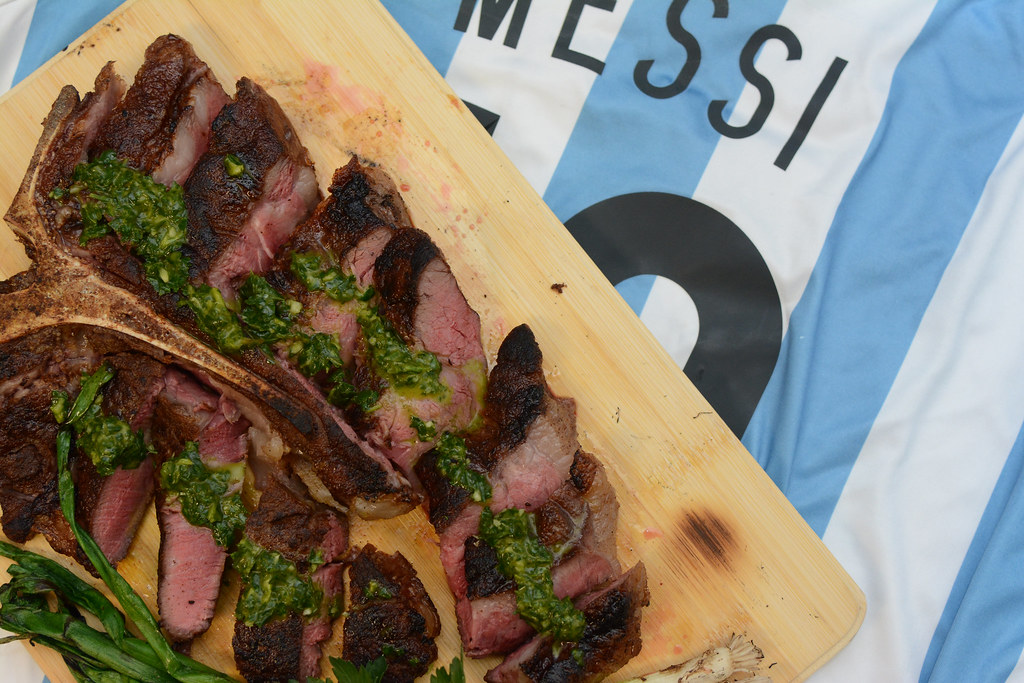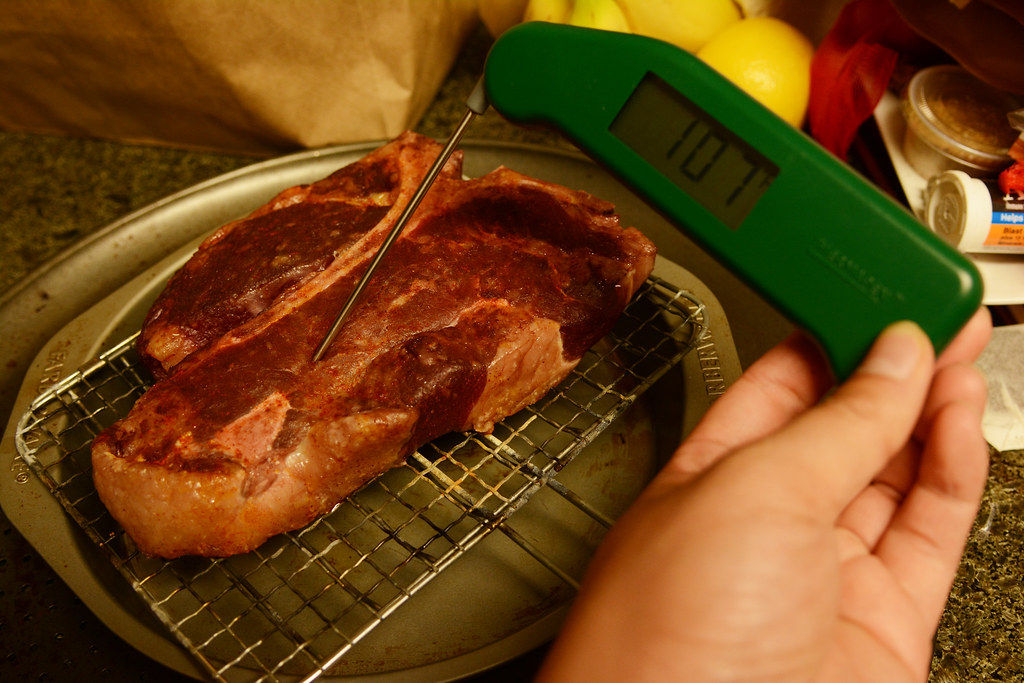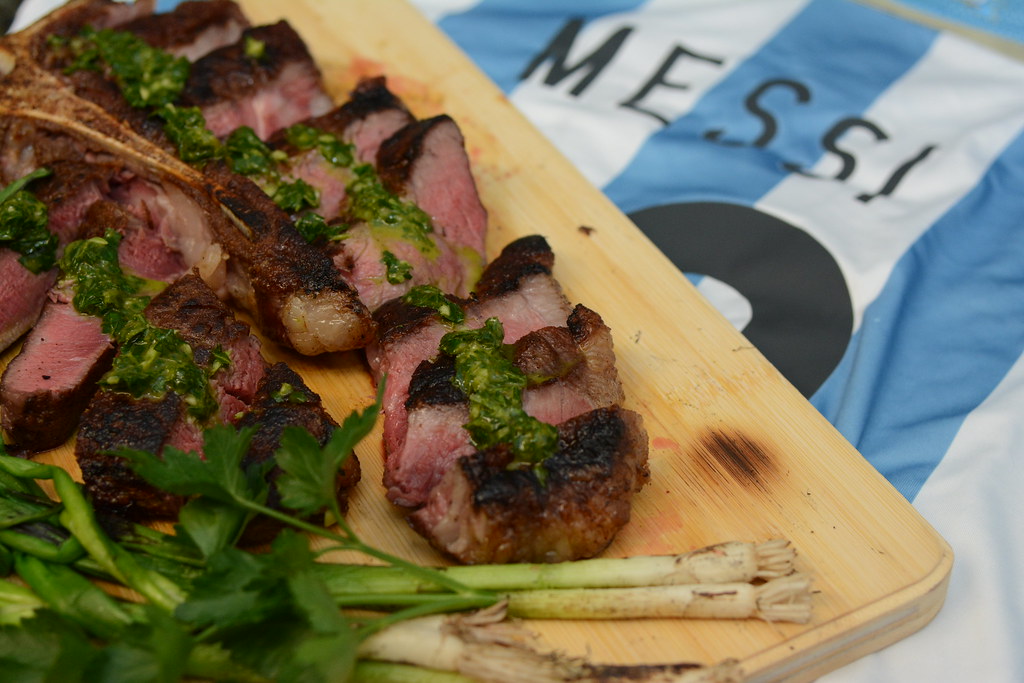Tuesday, May 12, 2015
A study in reverse searing. Argentine style porter house steak.
FC Barcelona had just ransacked Bayern Munich during the first leg of the Champions League semi finals, and to celebrate the best football player in the world, I made steak with an Argentine kick.
This was my first time making steak using the reverse sear method, and it came out wonderfully. A good cook is always testing new techniques and learning new ways to make their favorite meals.
In a previous post I talked about making the perfect steak by using the sous vide method. While steak cooked in that manner does come out pretty damn tasty for very little effort, the reverse sear gave me a much tastier steak, and for the same amount of work really.
The reverse sear is a similar ideology to cooking sous vide. You cook the steak at a low temperature until the internal temp reads close to your desired doneness, then you do a hard sear at the end to get the crusty goodness. By cooking at a low temperature, you reduce the grey banding that is found when steaks are cooked starting on a high heat.
The difference here is this low temperature cooking is done in the oven instead of in a water bath. The dry heat of the oven helps to dry out the exterior of the steak, meaning when you sear, it'll get a much nicer crust. You also get a subtle roasted flavor that is absent from cooking sous vide.
Personally, I think the biggest difference came from pre-salting. Most sous vide methods don't have you salt the steak until it comes out of the water bath. Salting pre-bath can sometimes lead to a cured texture, especially if cooking for long periods of time, which can be off-putting. However, I found that post salting just wasn't enough, and I had to add more salt at the dining table. Pre-salting or dry-brining, leads to moist, juicy, flavorful steak. The salt draws out the moisture from the steak and mixes with the salt, forming a brine. And, when given enough time, the salty liquid gets re-absorbed by the steak.
This was my first attempt at this method, and I think there's a ton more experimentation to be done, and a lot more steaks to eat.
Anyways, on to the instructions! This is more of a technique thing than a recipe and can be adapted to however you like your steaks served. I hope you try it out!
Reverse Seared Porter House.
Serves 2.
1 1.5lb porter house steak
salt (about 1 to 1.5 tsp)
smoked paprika (optional)
1. Liberally season the steak on both sides with salt and smoked paprika. It should look like it snowed all over the steak. Put the steak back in the fridge on a metal rack (to let air circulate around the steak) and let the steak rest for about an hour. The salt will draw out the moisture in the steak, and after maybe 20-30 minutes, this salty liquid will get reabsorbed into the steak.
2. On a metal rack over a baking sheet, place the steak into a very low temperature oven, as low as you can go. My oven's lowest temp is 170F, but yours might be different. Cook until the steak reads about 105-107F internal temperature. Take the steak out and let it rest for 10 minutes. The temperature will continue to rise during the resting period, and will rise even more after the searing stage, so you don't want to let the steak get any hotter or you'll end up over cooking it.
3. Meanwhile, heat up a stainless steel or cast iron pan over medium high heat. You'll want to get it super hot, smoking almost. Squirt in a tiny bit of corn or vegetable oil (not olive oil since the smoke point is too low) and throw the steak on the pan. Sear for 30 seconds per side. Make sure you open a window or a door, and turn off your smoke detectors because there will be a LOT of smoke.
4. Since the steak has already rested, you can carve and serve right away! I served the steak with a chimichurri sauce and some grilled green onions. Look at that beautiful thing. Almost no grey banding to speak of.




No comments:
Post a Comment